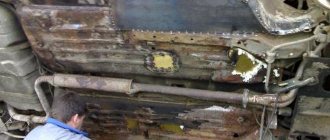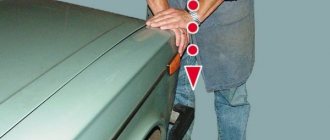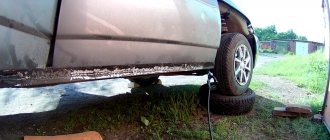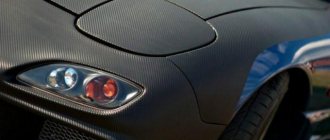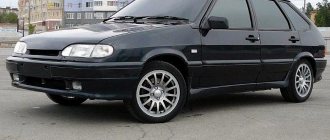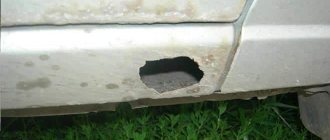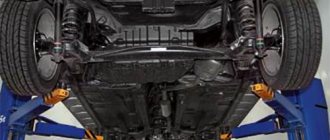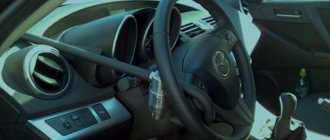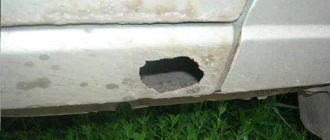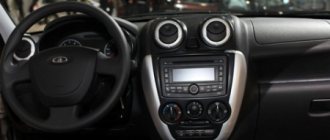If you decide to start painting your vehicle, it is likely that you will be faced with through holes in the body that have arisen as a result of exposure to rust. It is worth noting that body repairs are quite expensive, so not every car enthusiast wants to turn to professionals.
As a result, many are interested in how to repair holes in a car body without welding with their own hands. This is exactly what we will talk about now.
Methods for restoring a car floor
Let's look at effective methods of how to repair a hole in the bottom of a car without welding for a long time.
Fiberglass and epoxy patch application
To fill the void in the bottom of the car with fiberglass material, you must:
Prepare the metal, remove rotten parts, treat with a converter. Clean the surface from traces of dirt and grease. Cut several pieces of fiberglass. The first should exceed the size of the hole by 25-35 mm, the second by 35-45 mm, the third by 55-65 mm. For larger holes, 4-5 pieces of material may be needed. The patching begins by soaking the first patch with epoxy glue. The piece is carefully placed on the hole, the edges are smoothed with a roller or brush. The remaining fiberglass fragments are glued one by one
It is important to saturate the material well with resin. This will prevent moisture from seeping between the layers and destroying the adhesion of the glue.
It is recommended to apply the following patches with a 45 degree rotation. After hardening, the fiberglass will evenly distribute the load due to the displaced layers.
The next patches are applied after the previous ones have set. Work is carried out outside and inside the salon. After final hardening, the fiberglass can be sanded and prepared for the application of primer, bitumen mastic or paint.
Method for filling holes using putty
There are special types of putties on the market that contain fiberglass. They are used to seal small defects. Fiber filler increases the strength of the putty and resistance to mechanical stress.
The process of patching a hole is similar to using epoxy glue. The composition is applied in small portions in several stages
It is important to wait until the previous layer has set - this will prevent the wet putty from sagging and loss of strength.
This method requires careful degreasing of the edges of the defect. In addition to rust removal procedures, it is necessary to thoroughly treat the area with anti-silicone compounds. Otherwise, the putty will not bond properly to the metal.
Does the DVR suction cup not stick to the glass? Let's glue it tightly!
Soldering a metal patch
Soldering is one of the effective methods for repairing a hole in the bottom of a car without welding. But household soldering irons are not suitable for heating metal - the area is too large. Portable gas burners are used. For convenient access to the defect site, use a remote gas supply through a hose.
Solder and flux are required for soldering. A low-melting filler with a high content of tin and lead is used as a soldering mixture. The flux used is acidic; if not available, battery electrolyte can be used.
Soldering has two disadvantages:
- Fire hazard. If safety precautions are observed, this point is leveled out.
- Tin-lead solder causes electrochemical corrosion of the metal in the joint area. To reduce this effect, you need to thoroughly heat the overlapped joint.
Installation of galvanizing and riveted connections
The technique of applying new sheets with rivets is popular among garage workers. The technology allows you to repair small and large-scale defects without resorting to chemical components and careful preparation.
First, the affected part of the bottom is removed. The edges of the cut are cleaned to a shine, paint, primer, and traces of sound insulation are removed. A new sheet of zinc steel is cut along the contour. The connection points of the patch with the bottom are marked, and holes are drilled to the diameter of the rivet. Note that the patch sheet is cut with a margin of 5-10 mm, depending on the damage.
The next step is to install the steel rivets. The operation is performed with a manual or pneumatic gun. The second option significantly speeds up the process and relieves the burden on the master’s hands. Upon completion of fastening, the joint is treated with bitumen sealant, and the sheet is primed and painted in color.
It is more difficult to install metal patches on curved areas of the floor. The repairman will need the ability to form the correct geometry from a straight galvanized sheet. In the area of power elements (spars, spacers, etc.), it is allowed to install bolts in these units. Together with rivets, they “tighten” the structure and increase the mechanical strength of the floor.
Methods for unscrewing bolts, screws or screws with licked heads
How to repair through holes on a car body using putty without welding
Before repairing a hole in the car body, you should prepare:
- fiberglass and automotive putty;
- aluminum mesh;
- putty knife;
- sandpaper (if possible, it’s also worth looking for a sanding machine);
- primer, paint, varnish.
Fixing holes in a car body itself is distinguished by its simplicity. First of all, you should remove the rust using an angle grinder or any other suitable equipment. Next, we cut out the patch from aluminum, and then attach it to the body using masking tape. We apply a thin layer of fiberglass putty (here it is important not to touch the tape, because then you will have to remove it). When the putty sticks, peel off the tape and putty the remaining areas.
It is important that the layer is as thin as possible, without tubercles or other irregularities.
When everything is dry, sand everything using coarse sandpaper or a sander.
Having achieved a flat and smooth surface, apply a second ball of putty - automotive putty. We wait until it dries and level it again. Then the surface is primed (do not forget to cover the areas that do not require painting with film). When the primer is finished, you can paint the body.
It is worth noting that the patch will be more stable if you apply a couple of layers of putty on the back side. In addition, it is also possible to seal holes in the car body without welding using putty and without using a patch. In this case, it is necessary to apply a lining on the back side so that the composition is well fixed. On the other hand, this solution is only suitable for very small through holes.
Let's watch a detailed video on how to seal holes without welding:
Application of fiberglass and glue
For moderate damage, the method of sealing holes with fiberglass is often used. When this area has been processed and cleared of layers of paint and rust, it is necessary to cut several overlays from fiberglass, the size of the hole plus 2 centimeters. This area should be pre-primed and allowed to harden.
Auto repair kit
An overlay is applied to the dry surface and secured with a mixture (polyester or epoxy resin + glue). The next “part” is applied and also fixed. Thus, all the fiberglass parts are glued, placing them one on top of the other. To prevent them from sagging or deforming, you should put a lining. When the resin and glue have dried, you need to treat the work area and paint it.
Fiberglass
Fiberglass and epoxy patch application
The algorithm for sealing a hole in a car body using fiberglass and epoxy glue is quite simple.
- We clean the area of the body panel surface around the hole. Be sure to treat the cleaned surface with a rust converter.
- We cut out at least three fiberglass patches that are at least 20-30 millimeters larger than the size of the hole in the body on all sides. In this case, the first patch is larger by 20-30 mm, the second patch is larger by 30-40 mm, and the third patch is larger by 50-60 mm.
- It is necessary to saturate each patch with epoxy glue, which will not only glue them together, but will also prevent moisture from seeping in from the outside. This will also allow you to avoid future bubbles under the paint in this area of the patch, which arise due to the hygroscopicity of the material. Epoxy glue eliminates hygroscopicity.
- The hole is sealed on the back side of the body panel - from the inside of the body. Layers of fiberglass in epoxy glue are glued alternately. In this case, you should wait until the bottom layer of the patch dries before gluing the top layer.
- Next, the surface of the exposed part of the fiberglass is cleaned from the outside of the body panel. After this, a layer of putty is applied, and then the entire body panel is rubbed and painted with varnish.
Application of fiberglass and glue
For moderate damage, the method of sealing holes with fiberglass is often used. When this area has been processed and cleared of layers of paint and rust, it is necessary to cut several overlays from fiberglass, the size of the hole plus 2 centimeters. This area should be pre-primed and allowed to harden.
Auto repair kit
An overlay is applied to the dry surface and secured with a mixture (polyester or epoxy resin + glue). The next “part” is applied and also fixed. Thus, all the fiberglass parts are glued, placing them one on top of the other. To prevent them from sagging or deforming, you should put a lining. When the resin and glue have dried, you need to treat the work area and paint it.
Fiberglass
Installation of galvanizing and riveted connections
Processing holes in the bottom of a car with galvanized metal is quite common. The main material required for this is iron sheet. Before installation, it should be secured with self-tapping screws and lubricated with mastic. It is best to use an anti-noise bitumen mixture. The galvanized sheeting is then laid and bolted in place using a drill. Then you need to treat the area with special means and level the entire surface. When everything dries and the structure is fixed, it should be coated with paint.
Decoding the symbols on the buttons and connectors of the radio
https://youtube.com/watch?v=xug-dOUT16E
Another reliable option for filling holes is to make rivet joints. Using this technology, large and small holes can be eliminated. To do this, the damaged area is cut out and the edges are cleaned of paint and rust. Next, steel rivets are cut out, since they are least susceptible to corrosion. Then the part is applied and secured with these rivets. When the structure is completed, the entire area is painted.
Pneumatic riveter
So, there are several ways to repair holes in the bottom of a car without welding. You can use any method described in this article. Choose exactly the option that you can implement. And remember, it is possible and very pleasant to carry out any task on your own.
Algorithm for carrying out the process of eliminating a through hole by applying a patch with a soldering iron
Here's what to do:
- To begin with, it is recommended to thoroughly clean the rust from the corrosive area. You can use attachments and a drill (also another set of tools).
- A patch is cut from a piece of metal sheet. An option is to use a can of auto chemicals, etc.
The patch must cover the entire hole on the vehicle frame element.
- A powerful soldering iron is prepared, with which the patch is applied.
Soldering a metal patch
Soldering a metal element to a damaged area is a way to seal holes in the bottom or any other part of a car when you can close a small hole. To repair a machine using this technology, you must have the following tools:
- a piece of metal sheet;
- powerful soldering iron;
- flux or rust converter;
- putty;
- primer.
Materials in the car
So, first, the area that needs to be repaired is cleaned, paint, rust, and dirt are removed. Next, it is treated with flux and degreased. Then measurements are taken and a metal piece of the desired shape is cut out. Such an element will completely seal the hole, and the edges will overlap. When the part for the patch is ready, it is attached with a soldering iron. Then the edges of the patch are treated with flux. Finally, it is worth treating the area with putty and priming it. When the surface is dry, paint and a protective layer are applied.
This method of filling holes in the bottom of a car is the most popular. Experts note the durability of the soldered patches, since the connection is quite reliable. In addition, this method can be used to seal a hole of any size. In general, soldering a patch is quite simple, and even a beginner who does not have much experience in car repairs can handle it.
Sequence of actions when sealing holes in the bottom
BOTTOM REPAIR USING NON-WELD METHODS
It is worth noting right away that all operations that are performed on the car body without the use of welding methods are called by experts unprofessional, in other words, “garage”. This is due primarily to the fact that they do not represent the result of any innovative idea put into action; most often, the basis for independent work is the properties of the materials or other substances used in the work.
Such repair of the underbody of a car does not have any specific technology that has been tested by appropriate qualified people or special organizations; it is not burdened with norms and standards. The idea of self-repairing the body most likely came to experienced car owners who were savvy and adapted to specific domestic conditions. It is worth noting that in no European country would a self-respecting citizen engage in such actions; moreover, such an idea would not even occur to him. Damaged body parts are not repaired abroad; a damaged or old car is simply replaced with a new one. The car repair methods described below can mostly eliminate or hide through damage to the upper parts of the body or the underbody of the car.
When starting to repair the underbody of a car, you should take into account some requirements and basic rules by which almost all body work is carried out:
- you need to have a grinder with you, with its help you can cut out a rusty area or expand a damaged area;
- the area of the body or bottom that will be repaired with your own hands is first cleaned of all unnecessary things, in particular, old paint, lumps of dirt or rust;
- the prepared area must be degreased and treated with anticorrosive;
- the hole with the “patch” must be given its original appearance, i.e., upon completion of the repair work, the surface with the original configuration should be formed. Painting putty for cars can be an excellent assistant in this matter;
- As a result, the repaired body must be prepared for painting.
Work technology
The rivet connection method is the fastening of two or more metal sheets using cylindrical rods with heads at the ends. Holes are pre-drilled in the parts to be joined. A rivet, with one head made in advance, is inserted into the hole and the second head is formed. The heads of the rivets pull the sheets together and prevent them from being torn off. The rod of this fastener prevents the lateral mutual displacement of parts and is subject to shearing forces.
Rivet joints are used in body production:
- for securing sheets (of light alloys most often);
- for securing parts made of plastic materials;
- when assembling frames.
During repairs, this method is most often used to replace corroded body cladding when welding is unreliable. Riveted joints are especially common when repairing floors - the damaged area is replaced with a new panel. A properly executed rivet seam is as strong as a welded seam.
Cold methods of sealing holes in metal
There are two ways to repair holes in the underbody of a car without using hot work.
- Using composite materials - various types of polymer resins in combination with a reinforcing filler and a curing reaction accelerator. With high-quality surface treatment, in addition to restoring mechanical strength, they play the role of inhibitors - retarders of chemical and electrochemical corrosion reactions;
- Installing sheet material patches onto rivets.
General technological rules
Holes in the bottom are usually discovered from the outside, when inspecting the car on a pit or lift. Signs of through corrosion are local swellings, which, when you try to pick them out, crumble into dust.
If you find such troubles, you need to open and remove the pie of heat, noise and waterproofing on the floor in the cabin in the entire area where the sheet of iron forming the floor is welded to the power elements of the body - thresholds, tunnel and others. Then you will see the whole picture of the damage and will be able to take preventive measures in those places where corrosion has not yet become through.
Hole in the bottom of the car
Before the actual process of sealing the holes, you need to take measures to slow down the corrosion process (stopping it is an unattainable ideal to strive for). To do this, all rags of iron are removed, and the edges that have residual strength are treated with sandpaper and a wire brush until shiny. The cleaned surface is treated with rust converters. For example, the “Tsinkar” composition. Work is being carried out inside and outside.
The work makes sense if the total surface of through holes does not exceed 15% of the floor area.
Fixing pinholes
If the source of through corrosion has a diameter of no more than 1 centimeter, it can simply be covered with a two-component polymer composition. Poxipol glue or a cold welding kit similar to plasticine gives good results.
A small hole makes it possible to use so-called cathodic electrochemical protection. Find an aluminum rod, make a rivet out of it and fill the hole with it. Within a radius of 20 cm from it, corrosion will stop. True, the rivet will gradually collapse on its own. But this may take five years.
Repairing large-scale damage
In this case, you will have to take care to restore mechanical strength. If the hole is on a flat area, then there is no point in messing around with epoxy and fiberglass.
A truly durable composite material is obtained only with absolutely precise adherence to technology - mixing proportions, drying mode and much more. Use ready-made material of this kind, for example, textolite. Having a thickness of 3 mm, it is not inferior in strength to sheet iron. The plate can only be installed with epoxy glue, but it is better to use a combined connection using rivets. The latter should be made of aluminum, then they will play the role of cathodic protection.
Patches on the bottom of the car
Long holes at the joints with power elements are eliminated with patches made of sheet iron or aluminum. They need to be bent according to the shape of the joint so that the width of the contact zone with the still living material is at least 2 cm. They are installed on aluminum rivets; the use of an epoxy compound would be useful. Especially if sheet metal is used. After all, you cannot know exactly its composition and in which direction electrochemical corrosion will go - whether it will destroy the patch or the body. The polymer resin will act as an inhibitor.
Preparing to fill a hole in a car body
So, you have discovered a through hole in the body of your car. do not rush to turn to expensive craftsmen who guarantee the high quality of their work with a guarantee that rust will not appear in this place for many years. If you are limited in funds, such treatment will lead you into debt and taking out loans. An alternative to this development of the situation may be to repair the hole in the car body yourself.
First, you need to prepare to seal the hole in the car body. To do this, you need to go to the nearest car market or auto parts store. We will need materials for working with paintwork and metal car body panels:
- fiberglass and epoxy glue;
- high power soldering iron;
- a hammer with a wooden striker or a hammer and a wooden spacer;
— acid rust converter;
— putty, automotive enamel;
— two-component acrylic primer;
— two-component acid (phosphate) primer.
Next, the place on the car body is prepared where a through hole has appeared due to natural corrosion. It is necessary to thoroughly clean the surface at a distance of several centimeters around the hole in the body panel using sandpaper. We must remove a layer of varnish, paint, possible putty and sand off any traces of rust. The surface around the hole should be thoroughly treated with an anti-corrosion solution.
Repair of the VAZ-2110 underbody without welding
With any body repair, first of all, it is necessary to carry out an external inspection of the hardware, identify and note for yourself which areas are in poor condition and need repair or replacement. The condition of the bottom metal is determined in different ways:
- using a hammer and a core - if you think that there is rust in a certain area, you need to lightly hit the metal, check if there is rotten iron under the anti-corrosion coating;
- try to jack up the car on each side - if the thrust pads are rotten, this will be noticeable when you try to jack up the car;
- press in different places on the floor of the car - weak, rotten iron will bend under your feet;
- try to move the front seats back and forth in the cabin - problematic movement of the seats also often indicates the poor condition of the metal.
Any repair of sills and underbody using a non-welding method is not professional, and craftsmen consider it only a temporary measure to properly restore the condition of the body; a welding machine is indispensable. When repairing the bottom without welding, patches and new body elements are not welded, but installed on rivets or self-tapping screws (bolts), preparation and all other work is carried out in the same way as during traditional body repair using a welding machine.
Car underbody repair without welding - Metalworker's Guide
Due to many reasons, a car may require sudden bumper repairs, painting, or replacement of spare parts. Often repairing external damage to a car involves welding work.
However, the use of welding is only possible with the involvement of specialists; it requires time and serious financial investments, which is not always justified. If the damage appears “in the field,” so to speak, it becomes necessary to repair the car body with your own hands without welding.
Please note that these methods are not recommended when working with load-bearing parts. Next, we will consider the main non-welding repair options.
For the most part, such work is carried out to correct minor damage or as a temporary solution. They are perfect for field repairs, for example, for urgent repairs of a broken bottom. Independent work is not regulated by GOSTs.
Technical regulations were not developed specifically. All these decisions are prompted by life. In general, it’s a crutch. The advantage of these methods is the availability of materials and tools, ease of understanding and development, and, as a result, low cost.
The general essence of the work is to close through holes.
In general, car body repair without welding goes like this:
· First, the damaged area of the body is cleaned of dirt, paint and varnish coating, and pockets of corrosion are eliminated (followed by anti-corrosion treatment). · After eliminating the holes, level the surface.
· Then preparatory work begins, including puttying, priming, followed by the actual painting of the car.
· If necessary, the damaged part can be cut out (although you will have to contact a welder later).
Car body repair without welding: stages of work
Car body repairs without welding can be done by puttying, soldering, or using rivets. What makes them special?
The most unreliable method of repair is puttying. Used as a temporary solution to quickly eliminate a defect. According to the composition, putties come with small, medium and large fiberglass.
The latter are used for through holes. When sealing, the hole is filled with putty, placing something on the back side. This method is only suitable if the hole is small or located in a technological pocket.
Please note that the putty crumbles quickly.
First, the repair area is cleared of paint, then primed. They begin to caulk from the inside from the bottom up. If necessary, give the material time to dry.
Attention: when mixing the putty with the hardener, no bubbles should form. Everything should dry in the open air.
To eliminate large holes, you can use aluminum mesh as a basis for applying a layer of putty. The mesh is secured with tape, glue or tape.
For more reliable operation, fiberglass is used. Pieces are cut out of fiberglass in the shape of the hole and overlapped and glued to the metal. The pieces should overlap the required area by 2-3 centimeters. We fix all this with glue or tape. Linings are used to give a rigid base.
Don't forget to wait until everything dries. In principle, both of these methods can be used in combination. First fill the inside of the damage, then secure everything with fiberglass on the outside. Once again I emphasize the temporary nature of such repairs. If you need to get to a car service center, you can simply wrap everything tightly with tape.
It’s realistic to drive like this for a couple of days.
Car body repair without welding: we act quickly!
To eliminate large damage, you can solder a sheet of metal onto the hole. This requires some skills and equipment. The disadvantage is the price of materials. However, it is much more reliable and durable than gluing and much cheaper than welding. The sheet of metal is tightly soldered to the car body using flux to add strength.
To select materials, you need to familiarize yourself with the compatibility of alloys. Everything is done with an electric soldering iron. One metal patch is used according to the size of the hole. The place of future soldering is treated with a soldering iron (that is, we are mastering the craft of a tinker). Remember that the larger the soldering area, the more reliable the result will be.
After finishing the work, the soldered plate is straightened to the desired shape. Dents are puttied.
One of the most reliable methods available for repairing a car body without welding is the use of rivets. This method will eliminate serious damage and repair the case by replacing its parts.
This repair method consists of cutting out the damaged section of the body and replacing it with a new one, which is secured with steel rivets. Steel rivets are preferred to avoid corrosion. When repairing the bottom, this method is even better than welding.
If it is necessary to remove large dents in the threshold, several holes are made in it and, through them, the dent is straightened from the inside. Technical holes are sealed using the previously indicated methods and, together with the residual dent, are prepared for painting.
come back
Car underbody repair
The underbody of the car is more susceptible to aggressive environmental influences than other parts of it, and is also susceptible to mechanical damage. If it is possible to protect the bottom from corrosion, then this is unlikely to be possible from various types of damage.
The reason for this is often the unsatisfactory condition of the road surface.
In general, sooner or later a car owner will have to face the need to repair the bottom of his iron horse, especially if it has served its owner faithfully for many years.
Bottom overcooking - this diagnosis is often given to car owners at service stations. He sounds very serious and these words reek of a hopeless situation and the high cost of resolving it. Is it really? Situations are different, but often things are not as dire as car service specialists make them out to be. If you wish, you can do everything yourself.
Tricks
Masters at car repair shops most often exaggerate and tell the car owner that a rotten bottom requires a lot of painstaking work and the cost of a lot of materials. This is what accounts for such a high price.
At the same time, they try not to allow the owner to examine it, or they show problem areas in low light. In this case, ordinary dirt can be mistaken for oxidized rotten metal, which you just need to touch and it will crumble.
With the help of such small tricks, the colors are thickened, which allows you to inflate the price.
How to save money?
If a car owner wants to save money, he needs to do a preliminary inspection of the bottom himself. For this you will need:
- Lift, inspection hole, overpass.
- Good lighting: a flashlight or a carrier with a powerful lamp.
- Hammer.
Using a hammer, it is necessary to tap all suspicious areas of the bottom and determine the extent of their damage in order to approximately know the volume of materials needed.
If all of the above is not at hand or there is simply not enough time for a thorough inspection, then a special mirror for inspecting the underbody of the car will come to the rescue. It will allow you to generally assess the condition of the metal and get an approximate idea of the amount of work. But the situation will become completely clear only after a thorough examination.
The welding process itself is simple; anyone can master it in the shortest possible time. Sometimes it takes longer to connect and set up equipment.
The easiest way to overweld the underbody of a car is to use a semi-automatic welding machine. But often such repairs are simply impossible without the use of gas welding.
Best of all, when both of these devices are used, they complement each other and improve the quality of underbody repairs.
What is needed to repair the bottom?
As the saying goes: “If you want something done well, do it yourself.” Car underbody repair is no exception. To implement this you will need the following equipment:
- Semi-automatic welding machine.
- Gas welding.
- Regular metal scissors or electric.
- Grinder (angle grinder).
- Hammers of various sizes and configurations.
- Good lighting.
You also need to stock up on the following materials:
- Oxygen and calcium carbide (for gas welding).
- Carbon dioxide and copper wire (for a semi-automatic welding machine).
- Wheels for cutting and grinding metal on a grinder.
- Metal for patches.
Metal thickness
To repair the underbody of a car with your own hands without any problems, you need to choose metal of optimal thickness. Its recommended thickness varies from 1 to 2 mm.
But here you should take into account the qualifications of the person who will carry out the welding work. When working with thinner metal, you must strictly observe the temperature requirements during welding.
Which, in turn, depends on the debugging of equipment and the quality of consumables.
Thicker metal is more difficult to process, but it is also more difficult to damage or spoil. Therefore, before purchasing consumables, you need to realistically assess your qualifications as a welder.
Preparatory stage
Now you can begin the preparatory work. There is nothing complicated about this, and it will not be difficult to do them yourself. You just need to clean all the problem areas of the bottom from rust. This can be done in two ways.
Using a grinder. In this case, it is necessary to use both cutting and grinding wheels. During work, be sure to follow all safety regulations. It is better to clean hard-to-reach places from rust using gas welding.
After the impact of rusty metal and corrosion, the edges of the surface to which the patches will be attached must be thoroughly cleaned. It is advisable to do this work with a grinder. Now you can cut out the metal patches and start welding.
It is best to cut metal using manual or electric metal shears. This will allow you to make blanks of exact size and maintain straight edges. Cutting metal, especially thin metal, by welding requires high qualifications.
Types of rivets
Made from malleable metals. The most common are rivets made of aluminum and its light alloys, mild steel, brass, copper and others. There are types:
- simple;
- special.
Simple ones have a solid core. The factory head can be cylindrical, round or countersunk (flat). These fasteners are used when there is good access to both surfaces of the sheets being fastened, because a pneumatic or hand hammer is used to form the second head.
Special rivets have a tubular rod and the factory head has a hole in the center. The second cap is obtained by pulling and then tearing off the mandrel (rod with a thickened end). The result is a head in the form of a thick shoulder. The second method is to push the cylindrical rod, as a result of which the inner shoulder expands and transforms into an outer one. Special ones are used in cases:
- the back surface of the joined sheets is inaccessible or difficult to access;
- for bonding metal to laminated plastic parts;
- for fastening decorative parts.
Method for filling holes using putty
In the area of the hole in the bottom, the damaged coating, that is, the old layer of paint, should be removed, the metal should be cleaned, and treated with a special preparation - a rust converter. Then the working surface is degreased and primed. Next, prepare a putty solution of uniform consistency. For greater efficiency, fiberglass is added to it (most often with large elements). Then the composition is carefully applied to the damaged area. This is perhaps the most important part of the job. It is necessary to seal all the holes, cracks and microcracks that may arise around it. Application of the solution should occur in several stages, allowing each new layer to dry.
Sealing with putty
To achieve maximum fixation of the putty on the damaged area, a backing is applied to the reverse side. It does not allow the solution to spread, but acts in the area that needs to be repaired. If the hole in the bottom of the car is large enough, this repair method can also be used with auxiliary elements. Instead of a lining, a metal mesh is installed in the damaged area. Therefore, the putty is evenly distributed over it, filling the entire space. After the solution has completely dried, this area is treated with automotive paint putty. Then the damaged area is painted and a protective film is applied.
Putty for cars
How to fix a hole in the bottom of a car without welding
When getting your car in order, sometimes you have to find an unpleasant problem - a through hole in the bottom of the body.
Some car owners immediately turn to a car service center for help, while others try to repair the hole on their own.
In the second case, you have the opportunity to save time and money, and will also be able to master new car repair techniques, which is always useful and relevant.
Holes in the bottom
Many people do not have a large number of repair and construction tools and equipment, so not every car owner has a welding machine in their garage or workshop. In fact, if the hole in the body is no larger than a matchbox, it is quite possible to repair it yourself without welding. There are several ways to do this:
- cover the hole with putty;
- solder a metal patch;
- seal with epoxy resin;
- apply fiberglass and glue;
- install rivet connections;
- use galvanized metal sheet.
Galvanized sheet
Method for filling holes using putty
In the area of the hole in the bottom, the damaged coating, that is, the old layer of paint, should be removed, the metal should be cleaned, and treated with a special preparation - a rust converter. Then the working surface is degreased and primed. Next, prepare a putty solution of uniform consistency.
For greater efficiency, fiberglass is added to it (most often with large elements). Then the composition is carefully applied to the damaged area. This is perhaps the most important part of the job. It is necessary to seal all the holes, cracks and microcracks that may arise around it.
Application of the solution should occur in several stages, allowing each new layer to dry.
Sealing with putty
To achieve maximum fixation of the putty on the damaged area, a backing is applied to the reverse side. It does not allow the solution to spread, but acts in the area that needs to be repaired.
If the hole in the bottom of the car is large enough, this repair method can also be used with auxiliary elements. Instead of a lining, a metal mesh is installed in the damaged area. Therefore, the putty is evenly distributed over it, filling the entire space.
After the solution has completely dried, this area is treated with automotive paint putty. Then the damaged area is painted and a protective film is applied.
Putty for cars This method of filling holes in a car is the simplest. But experts do not recommend using it, since the putty allows moisture to pass through and can deteriorate over time. Holes are also treated with a solution when repairs need to be done urgently and there are no other alternatives.
Soldering a metal patch
Soldering a metal element to a damaged area is a way to seal holes in the bottom or any other part of a car when you can close a small hole. To repair a machine using this technology, you must have the following tools:
- a piece of metal sheet;
- powerful soldering iron;
- flux or rust converter;
- putty;
Materials in the car
So, first, the area that needs to be repaired is cleaned, paint, rust, and dirt are removed. Next, it is treated with flux and degreased. Then measurements are taken and a metal piece of the desired shape is cut out.
Such an element will completely seal the hole, and the edges will overlap. When the part for the patch is ready, it is attached with a soldering iron. Then the edges of the patch are treated with flux. Finally, it is worth treating the area with putty and priming it.
When the surface is dry, paint and a protective layer are applied.
This method of filling holes in the bottom of a car is the most popular. Experts note the durability of the soldered patches, since the connection is quite reliable. In addition, this method can be used to seal a hole of any size. In general, soldering a patch is quite simple, and even a beginner who does not have much experience in repairing cars can handle it. Sequence of actions when soldering holes in the bottom
Application of fiberglass and glue
For moderate damage, the method of sealing holes with fiberglass is often used. When this area has been processed and cleared of layers of paint and rust, it is necessary to cut several overlays from fiberglass, the size of the hole plus 2 centimeters. This area should be pre-primed and allowed to harden.
Auto repair kit
An overlay is applied to the dry surface and secured with a mixture (polyester or epoxy resin + glue). The next “part” is applied and also fixed.
Thus, all the fiberglass parts are glued, placing them one on top of the other. To prevent them from sagging or deforming, you should put a lining.
When the resin and glue have dried, you need to treat the work area and paint it.
Fiberglass
Installation of galvanizing and riveted connections
Processing holes in the bottom of a car with galvanized metal is quite common. The main material required for this is iron sheet. Before installation, it should be secured with self-tapping screws and lubricated with mastic.
It is best to use an anti-noise bitumen mixture. The galvanized sheeting is then laid and bolted in place using a drill. Then you need to treat the area with special means and level the entire surface.
When everything dries and the structure is fixed, it should be coated with paint.
Another reliable option for filling holes is to make rivet joints. Using this technology, large and small holes can be eliminated.
To do this, the damaged area is cut out and the edges are cleaned of paint and rust. Next, steel rivets are cut out, since they are least susceptible to corrosion.
Then the part is applied and secured with these rivets. When the structure is completed, the entire area is painted.
Pneumatic riveter
So, there are several ways to repair holes in the bottom of a car without welding. You can use any method described in this article. Choose exactly the option that you can implement. And remember, it is possible and very pleasant to carry out any task on your own.
Rivet seam
Regardless of the type, when repairing, it is necessary to use rivets of the same material as the sheets being fastened. Aluminum fasteners will gradually deteriorate if they are used to rivet brass, copper, corrosion-resistant or ordinary steel. In a more humid atmosphere, this process will be more noticeable, since electrolytic pairs are formed.
Important parameters of rivet fastening are the distances from the edge of the sheet to the center of the rivets and the pitch size (the distance between the axial axes of adjacent fastening elements mounted along the same line - the seam). The pitch size is a multiple of the fastener diameter and depends on the purpose of the riveted part. For the example above, with a diameter of 4 mm, the length of the riveting rod is 8 mm. The step size is 40 mm. From the edge of the sheet to the axis of the seam - 8 mm. In some cases, when repairing a body, they focus on the spot welding step and mark the installation of fasteners using it.
Installation procedure for simple rivets:
- The sheets are fastened with bolts through 5 - 6 holes drilled for rivets. Mismatched holes are processed by re-drilling or by reaming.
- The fastener is installed with the head to a thinner sheet.
- The head of the fastener is mounted on a massive anvil. Use a riveting stand for round heads - this will protect the head from deformation.
- A mandrel is placed on the riveting rod and struck several times with a hammer. The sheets should be pressed towards the cap.
- The upsetting mandrel is removed and blows are made along the axis of the fastener rod. As a result, the fastening element, crumpling, first fills the hole and then forms a blank for the closing head.
- The edges of the stave are struck at an angle, forming a head.
- A riveting mandrel is installed on the head and the formation is completed. When riveting fasteners with countersunk heads, as a result of flattening with a hammer, the metal crumples and fills the countersink.
- The mounting bolts are removed and fasteners are installed in their place.
Installation of special rivets:
- Item 1 for simple fastening elements.
- The rivet is inserted into the hole, and a rolling rod is inserted into the broaching device.
- The head is pressed forcefully against the sheets, which are pressed together.
- The tensioning device is activated until the fastener rod comes off.
- P.8 for simple ones.
Application for riveting the piercing rod:
- In most cases, the piercing rod is driven in with a hammer. During operation, it is necessary to control the tightness of the sheets adhering to each other, applying force near the riveting head.
- The head is pressed against the sheets under the action of advancing the piercing rod (it is struck with a hammer).
For mechanical installation of simple rivets, a pneumatic hammer is used. Short successive blows lead to the formation of the head. When using fasteners made of aluminum and light alloys, pneumatic guns are used to form the head in 1 blow. Special rivets are installed mechanically if the rolling rod is of the pulling type.
Defects during riveting:
- occurrence of simple rivets;
- a thickening forms between the sheets - as a result, the size of the head decreases;
- poor flaring of special fastener elements is a consequence of insufficient length;
- the mobility of the rivet in the hole is a consequence of the large gap between the hole and the inserted fastener, which does not extend enough to fill the gap.
Drilling holes for rivets
The hole is drilled with a diameter slightly larger than that of the riveting rod. However, you should strive to obtain the smallest gap, since in this case:
- simple fastening elements have less bending potential;
- special ones roll better.
In practice, during repairs, the diameter of the hole is determined by the size of the available drills. For small diameter rivets used in tinsmithing, the total clearance should be within 0.5 mm. If possible, the hole should be processed - remove burrs from the inner surface that were formed during drilling.
Before drilling the sheets, select the length and diameter of the rivets. For example, for mounting a 1.0 mm sheet on the floor of a body with a metal thickness of 0.6 mm, the diameter of the fastening element will be approximately 4.0 mm. If special rivets are used, the sheets being joined may be thicker than is acceptable for simple ones. This applies if the fastening elements are subject to low forces. Body trim sheets are subject to vibration loads, torsional and bending stresses that arise when the vehicle moves on an uneven road. They make the fastener “play.” Since in the case of large forces it is necessary to take the diameter of the fastening element larger than the calculated one, then for the above example the diameter will be 5.0 mm.
The length of the rivets is selected depending on their type. In simple ones, it is determined by the length of the rod. Therefore, the length of the fastening element is calculated as the sum of the thicknesses of the parts being connected and the thickness of the metal required to fill the gap between the hole and the riveting and to form the head. When forming a round closing head, a rod length equal to 1.5 times the diameter is added to the total thickness of the sheets. To determine the dimensions of special fasteners, use tables supplied by manufacturers.
General technological rules
A sign of the active process of metal decay is the formation of local bubbles. You can find them on an inspection hole or lift. When you try to tap a hole, its edges begin to crumble into small pieces. This is a clear sign of impending renovation.
If a defect is detected, it is necessary to open the layer of insulating material in the interior. The area of the “pie” to be removed should be one and a half to two times larger than the most problematic area. This is due to the fact that the hole needs to be cleaned further than the edges. Ideally, it is recommended to remove the trim and seat where repairs are to be carried out. This way you can evaluate the entire picture of damage and localize new areas of corrosion.
Corrosion is like a fungus; it spreads over the entire area of the metal. To do this, rotten pieces are removed, the surface is cleaned until a shiny layer appears. In practice, cleaning can go far from the main focus. Example: a hole of 1-2 cm requires grinding up to 15-20 cm around the perimeter.
After restoring an entire layer of metal, it is necessary to treat its structure with corrosion inhibitors - converters. Treatment is carried out inside and outside.
Method for filling holes using putty
In the area of the hole in the bottom, the damaged coating, that is, the old layer of paint, should be removed, the metal should be cleaned, and treated with a special preparation - a rust converter. Then the working surface is degreased and primed. Next, prepare a putty solution of uniform consistency. For greater efficiency, fiberglass is added to it (most often with large elements). Then the composition is carefully applied to the damaged area. This is perhaps the most important part of the job. It is necessary to seal all the holes, cracks and microcracks that may arise around it. Application of the solution should occur in several stages, allowing each new layer to dry.
To achieve maximum fixation of the putty on the damaged area, a backing is applied to the reverse side. It does not allow the solution to spread, but acts in the area that needs to be repaired. If the hole in the bottom of the car is large enough, this repair method can also be used with auxiliary elements. Instead of a lining, a metal mesh is installed in the damaged area. Therefore, the putty is evenly distributed over it, filling the entire space. After the solution has completely dried, this area is treated with automotive paint putty. Then the damaged area is painted and a protective film is applied.
Putty for cars
Filling holes in the body with putty
As a rule, holes most often appear on the bottom of the car. And in this case, everything around is thoroughly cleaned, car cosmetics (rust converter) and many other kits are used. Degreasing and priming are also required.
The technology of direct application of putty, without the use of a patch, involves application from the back side of the lining area. In this way, it will be possible to significantly achieve maximum fixation of the composition. You can use a metal mesh instead of a lining as such. These are even sold in stores, you can make them yourself, etc.
The putty must be evenly distributed over the surface, filling the entire space of the hole. After the solution has dried, the area is treated with painting putty. Then, after drying, they paint and put on a protective film.
This option for eliminating a through hole in the body is the simplest. Experts, however, do not recommend using it, since the putty will begin to leak moisture over time and will collapse. This method is most suitable if restoration is urgently needed and there are no other alternatives.
Weldless auto repair options
Car body repairs without welding are considered unprofessional, since this is not the product of numerous scientific research. There are several ways.
General requirements: the damaged area is removed with a grinder or chisel. Anticorrosive and zinc are applied and degreased. Next, the holes are sealed with paint putty, creating a surface of a suitable shape, and painted.
Puttying a car
The material used is fiberglass with the structure:
- small;
- average;
- large.
The coarse fiber composition is suitable for repairing minor damage. Applicable when they are located near structural pockets. The composition of the lining is fixed, placed on the inside. Puttying is a budget option, but it is not very reliable.
A layer of putty is applied to the cleaned, primed metal surface. First inside, then the surface is worked. After the starting layer has hardened, the second layer comes on. Drying is done at room temperature.
The use of aluminum/brass mesh makes it possible to repair significant damage. The hole is covered with a mesh and secured with tape. After puttying and processing, the tape is removed.
Fiberglass + synthetic glue
Large damages are repaired with fiberglass. The adhesive is epoxy or polyester resin. Fiberglass fabric is applied in several layers, each overlapping the previous one by 2 cm.
Everything is coated with adhesive. Fabric sagging is eliminated by installing linings. Drying is in progress. This option is suitable for minor damage.
Soldering
A method for removing significant body damage. The metal patch is pressed against the body and connected with solder. Flux will give strength. Solder and flux are selected based on metal alloys. They work with a high-power electric soldering iron.
Negative points:
- high cost of solder;
- low strength.
The metal patch should cover the hole without a gap. The initial stage is tinning the surface. The protruding overlay is hammered down. Next - puttying and painting.
Rivets
Option for repairing large damaged areas and replacing parts. The method is preferable to welding when repairing the bottom. The damaged area is removed and a new piece of metal or part is placed. They are riveted with steel rivets, diameter - 5 mm, for load-bearing elements - 6 mm.
Before placement, the rivets are treated with an anti-corrosion substance. A riveter is required.
Other methods
The bottom is repaired with galvanized sheets using bolted connections. The damaged area is removed with an angle grinder. Cut out 2 pieces of galvanized metal - for the top and bottom. The floor is coated with bitumen mastic on both sides. Galvanization is also processed.
Mount the lower component, securing it with self-tapping screws. Long ends are removed. Install the upper component. Fastened with M5 bolts. The fasteners go along the perimeter to avoid bending of the sheets.
Repair of box-shaped body elements without welding equipment is carried out by drilling holes. Then the tool is inserted and the fault is corrected. The hole is sealed using any of the above methods.
Car body repair without welding: do-it-yourself repair, video
Watch this video on YouTube
Car underbody repair without welding
The underbody of the car is more susceptible to aggressive environmental influences than other parts of it, and is also susceptible to mechanical damage. If it is possible to protect the bottom from corrosion, then this is unlikely to be possible from various types of damage.
The reason for this is often the unsatisfactory condition of the road surface.
In general, sooner or later a car owner will have to face the need to repair the bottom of his iron horse, especially if it has served its owner faithfully for many years.
Bottom overcooking - this diagnosis is often given to car owners at service stations. He sounds very serious and these words reek of a hopeless situation and the high cost of resolving it. Is it really? Situations are different, but often things are not as dire as car service specialists make them out to be. If you wish, you can do everything yourself.
Welding process
It is advisable to use two people to weld the bottom. It will be difficult for one person to fix the patch and scald it at the same time. If the metal is applied to a flat surface, then it is faster to fix it using a semi-automatic welding machine.
If it is necessary to make a bend, you should resort to gas welding. When heated, the metal becomes soft and can be bent and given the desired configuration using a hammer. It should not be forgotten that high temperature reduces the properties of the metal. Another option in this case could be a special device designed to create bends on metal workpieces.
After completing the welding work, all seams must be cleaned with a grinder and coated with anti-corrosion compounds.
And this option is possible. It is enough to simply periodically inspect the bottom, if necessary, clean the places where rust has appeared and coat them with special compounds.
This method will save time, money and nerves of the car owner. You won’t need to pay huge sums to service station technicians or learn the profession of a welder.
Tired of paying fines? There is an exit!
Forget about fines from cameras! An absolutely legal new product - NANOFILM, which hides your license plates from IR cameras (which are installed in all cities). Read more about this at the link.
- Absolutely legal (Article 12.2.4).
- Hides from photo and video recording.
- Installs independently in 2 minutes.
- Invisible to the human eye, does not deteriorate due to weather.
- 2 year warranty
Self-repair of the underbody of a VAZ-2110 car
The car body is subject to corrosion over the years, and it begins to rust especially quickly if you do not take care of it and do not apply an anti-corrosion coating. How quickly body parts begin to rust also largely depends on the quality of the iron, factory processing; over time, the car requires repairs to the underbody, sills, side members, wheel arches, and so on.
Rusted sills and a rotten bottom are a fairly common problem on VAZ-2110 cars, and since such work in a car service center is quite expensive, many car owners try to repair the car with their own hands. You can patch holes in the body and bring the car back to normal by yourself using various methods; there are non-welding methods, but basically all car owners try to make repairs using welding.
Repair of the VAZ-2110 underbody without welding
With any body repair, first of all, it is necessary to carry out an external inspection of the hardware, identify and note for yourself which areas are in poor condition and need repair or replacement. The condition of the bottom metal is determined in different ways:
- using a hammer and a core - if you think that there is rust in a certain area, you need to lightly hit the metal, check if there is rotten iron under the anti-corrosion coating;
- try to jack up the car on each side - if the thrust pads are rotten, this will be noticeable when you try to jack up the car;
- press in different places on the floor of the car - weak, rotten iron will bend under your feet;
- try to move the front seats back and forth in the cabin - problematic movement of the seats also often indicates the poor condition of the metal.
Any repair of sills and underbody using a non-welding method is not professional, and craftsmen consider it only a temporary measure to properly restore the condition of the body; a welding machine is indispensable.
When repairing the bottom without welding, patches and new body elements are not welded, but installed on rivets or self-tapping screws (bolts), preparation and all other work is carried out in the same way as during traditional body repair using a welding machine.
Tools and materials for car underbody repair
Before you begin restoring the body in the traditional way (using welding), you need to prepare everything you need, the tools you will need are:
- welding machine;
- Bulgarian;
- electric drill with drills;
- screwdrivers;
- hammer.
To remove old noise insulation, you may need a chisel; you can remove noise faster and more efficiently using a hammer drill.
To clean metal, you need sandpaper of various grain sizes; to increase productivity, it is recommended to use a sanding machine.
It is also impossible to do without materials when repairing the bottom; a lot here depends on the volume of restoration work. Most often you have to use:
- patches (pieces of new iron) or ready-made spare parts, for example, floor members, panels, threshold reinforcements, etc.;
- priming;
- rust converter;
- anti-corrosion and sound-proofing materials (you can use Movil, Tektil, bitumen mastic, Dinitrol, Prim Antishum, etc.).
Since the brake and fuel pipes under the bottom often rust thoroughly, stick and do not come off, in many cases they also require replacement.
Preparatory work
Before installing new frames on the bottom or welding body parts, you need to make preparations and partially disassemble the car:
- remove the seats;
- remove carpet;
- dismantle the old sound insulation;
- put aside electrical wiring in those places where repairs will be carried out.
Before replacing individual elements or installing patches, the entire metal surface is freed from old sound insulation, thoroughly washed and wiped, and cleaned using a grinder, a sanding machine or sandpaper. Then the metal should be degreased and treated with a rust converter; only after this can you begin working directly with the iron.
Replacement of car underbody elements
Most often, when replacing individual parts of the bottom or installing patches, welding is used; a semi-automatic welding machine is best suited for such repairs. If an entire separate part is being changed, for example a cross member, you can drill out the rivets and dismantle the element without welding.
When the bottom and sills are changed at the same time, the latter are removed from the car first, and when replacing sills it is important to control the geometry of the body.
Rivet seam
Regardless of the type, when repairing, it is necessary to use rivets of the same material as the sheets being fastened. Aluminum fasteners will gradually deteriorate if they are used to rivet brass, copper, corrosion-resistant or ordinary steel. In a more humid atmosphere, this process will be more noticeable, since electrolytic pairs are formed.
Important parameters of rivet fastening are the distances from the edge of the sheet to the center of the rivets and the pitch size (the distance between the axial axes of adjacent fastening elements mounted along the same line - the seam). The pitch size is a multiple of the fastener diameter and depends on the purpose of the riveted part. For the example above, with a diameter of 4 mm, the length of the riveting rod is 8 mm. The step size is 40 mm. From the edge of the sheet to the axis of the seam - 8 mm. In some cases, when repairing a body, they focus on the spot welding step and mark the installation of fasteners using it.
Installation procedure for simple rivets:
- The sheets are fastened with bolts through 5 - 6 holes drilled for rivets. Mismatched holes are processed by re-drilling or by reaming.
- The fastener is installed with the head to a thinner sheet.
- The head of the fastener is mounted on a massive anvil. Use a riveting stand for round heads - this will protect the head from deformation.
- A mandrel is placed on the riveting rod and struck several times with a hammer. The sheets should be pressed towards the cap.
- The upsetting mandrel is removed and blows are made along the axis of the fastener rod. As a result, the fastening element, crumpling, first fills the hole and then forms a blank for the closing head.
- The edges of the stave are struck at an angle, forming a head.
- A riveting mandrel is installed on the head and the formation is completed. When riveting fasteners with countersunk heads, as a result of flattening with a hammer, the metal crumples and fills the countersink.
- The mounting bolts are removed and fasteners are installed in their place.
Installation of special rivets:
- Item 1 for simple fastening elements.
- The rivet is inserted into the hole, and a rolling rod is inserted into the broaching device.
- The head is pressed forcefully against the sheets, which are pressed together.
- The tensioning device is activated until the fastener rod comes off.
- P.8 for simple ones.
Application for riveting the piercing rod:
- In most cases, the piercing rod is driven in with a hammer. During operation, it is necessary to control the tightness of the sheets adhering to each other, applying force near the riveting head.
- The head is pressed against the sheets under the action of advancing the piercing rod (it is struck with a hammer).
For mechanical installation of simple rivets, a pneumatic hammer is used. Short successive blows lead to the formation of the head. When using fasteners made of aluminum and light alloys, pneumatic guns are used to form the head in 1 blow. Special rivets are installed mechanically if the rolling rod is of the pulling type.
Defects during riveting:
- occurrence of simple rivets;
- a thickening forms between the sheets - as a result, the size of the head decreases;
- poor flaring of special fastener elements is a consequence of insufficient length;
- the mobility of the rivet in the hole is a consequence of the large gap between the hole and the inserted fastener, which does not extend enough to fill the gap.
Soldering a metal patch
Soldering a metal element to a damaged area is a way to seal holes in the bottom or any other part of a car when you can close a small hole. To repair a machine using this technology, you must have the following tools:
- a piece of metal sheet;
- powerful soldering iron;
- flux or rust converter;
- putty;
- primer.
Materials in the car
So, first, the area that needs to be repaired is cleaned, paint, rust, and dirt are removed. Next, it is treated with flux and degreased. Then measurements are taken and a metal piece of the desired shape is cut out. Such an element will completely seal the hole, and the edges will overlap. When the part for the patch is ready, it is attached with a soldering iron. Then the edges of the patch are treated with flux. Finally, it is worth treating the area with putty and priming it. When the surface is dry, paint and a protective layer are applied.
This method of filling holes in the bottom of a car is the most popular. Experts note the durability of the soldered patches, since the connection is quite reliable. In addition, this method can be used to seal a hole of any size. In general, soldering a patch is quite simple, and even a beginner who does not have much experience in car repairs can handle it.
Sequence of actions when sealing holes in the bottom
Car underbody repair
The underbody of the car is more susceptible to aggressive environmental influences than other parts of it, and is also susceptible to mechanical damage. If it is possible to protect the bottom from corrosion, then this is unlikely to be possible from various types of damage.
The reason for this is often the unsatisfactory condition of the road surface.
In general, sooner or later a car owner will have to face the need to repair the bottom of his iron horse, especially if it has served its owner faithfully for many years.
Bottom overcooking - this diagnosis is often given to car owners at service stations. He sounds very serious and these words reek of a hopeless situation and the high cost of resolving it. Is it really? Situations are different, but often things are not as dire as car service specialists make them out to be. If you wish, you can do everything yourself.
